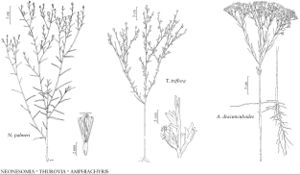Difference between revisions of "Neonesomia palmeri"
Sida 21: 253. 2004.
Common names: Texas desert goldenrod Texas goldenweed
Illustrated
Basionym: Aster palmeri A. Gray Proc. Amer. Acad. Arts 17: 209. 1882
Synonyms: Ericameria austrotexana M. C. Johnston Xylothamia palmeri (A. Gray) G. L. Nesom
FNA>Volume Importer |
imported>Volume Importer |
||
| (One intermediate revision by the same user not shown) | |||
| Line 8: | Line 8: | ||
}} | }} | ||
|common_names=Texas desert goldenrod;Texas goldenweed | |common_names=Texas desert goldenrod;Texas goldenweed | ||
| + | |special_status={{Treatment/ID/Special_status | ||
| + | |code=F | ||
| + | |label=Illustrated | ||
| + | }} | ||
|basionyms={{Treatment/ID/Basionym | |basionyms={{Treatment/ID/Basionym | ||
|name=Aster palmeri | |name=Aster palmeri | ||
| Line 60: | Line 64: | ||
|publication title=Sida | |publication title=Sida | ||
|publication year=2004 | |publication year=2004 | ||
| − | |special status= | + | |special status=Illustrated |
| − | |source xml=https:// | + | |source xml=https://bitbucket.org/aafc-mbb/fna-data-curation/src/2e0870ddd59836b60bcf96646a41e87ea5a5943a/coarse_grained_fna_xml/V19-20-21/V20_164.xml |
|tribe=Asteraceae tribe Astereae | |tribe=Asteraceae tribe Astereae | ||
|genus=Neonesomia | |genus=Neonesomia | ||
Latest revision as of 20:00, 5 November 2020
Stems: bark tan, becoming brown to gray; twigs mostly green, prominently ridged. Leaves moderately crowded; blades spreading, 10–30 × 1–2 mm, plane; axillary fascicles rarely present. Phyllaries 1.5–5.2 × 0.8–1.2 mm, midveins enlarged near apex, resin gland and surrounding tissue evident as green to brown patches. Ray laminae 2.5–3 × 0.5–1 mm. Disc corollas 3.8–5.5 mm, tubes glabrous, lobes unequal, 1–2.7 mm; style branches 1.5–2.2 mm, appendages 0.7–1.1 mm. Cypselae 1.5–2 mm; pappi 3.7–5.3 mm. 2n = 18.
Phenology: Flowering fall.
Habitat: Associated with brushy vegetation, brushy pastures, saline flats, coastal dunes
Elevation: 0–600 m
Distribution

Tex., Mexico (Nuevo León, Tamaulipas).
Discussion
Neonesomia palmeri grows on open flats to steep slopes in saline to sandy habitats in southern Texas.
Selected References
None.
Lower Taxa
None.
